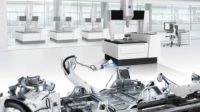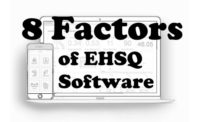Coordinate Metrology Society
9 Things to Consider When Buying CMM Inspection Software
AN Evaluation checklist helps find the value-add in inspection software.

CMMs are vital measurement systems for many quality departments. Of the many active components of these systems, the software used to control and record the measurement of parts is critical to getting the most complete performance out of your machine. It is important to be diligent in your search for the software package that will best fit your needs.
At a minimum, a CMM software program should provide functionality for basic tasks such as measurement routines, probe calibration, basic plane-line-point alignments, and data reporting among other features. But in terms of addressing a company’s unique applications and getting the best value for a system now and in the future, there are other main factors to consider in your quest for new software. These factors can help define the “added value” for your due diligence efforts when evaluating different software programs. Your evaluation checklist should include these nine important considerations:
Programming
Programming all comes back to ease of repeatability. Quality professionals write programs to record measurement routines and save time and energy upon repetition. When looking at available programming options, there are a couple of important factors. One such factor is diversity of programming languages. For experienced users, the dimensional measuring interface standard (DMIS) will allow for powerful programming using the same standardized language that they have been using for decades. For less experienced users, who may not have the same DMIS prowess, a native programming engine that is ergonomic and intuitive, more visual and feature oriented, can ensure that users do not fight the code.
In addition, look for powerful tools that can boost efficiency in the writing of inspection programs and drastically reduce the number of mouse clicks and data entry required. Such tools might include the ability to work with a CAD model that has embedded GD&T, serial feature builders for rapid pattern creation and measurement, and generic feature builders to allowing users to rapidly define and measure a series of features regardless of the type. CMM software that includes features that allow the code to “practically write itself” provide added value for the operator by decreasing the time and effort necessary to measure parts.
Alignment Variety
While most CMM software programs can handle simple alignments, not all part geometries are easily accommodated. Consider software that allows for a wider variety of user friendly alignment methods to align even the most complex part geometries. One such feature is a strong surface engine to allow for alignments based upon surface features of the CAD model. This capability allows for many more alignment strategies than a strictly DMIS based software limited by the requirements of the standard. This enables the user to quickly and easily align even the most complex parts in just a few clicks.
Dynamicity
How much time do users spend on each part re-computing features and alignments as changes are made? Often a change to a single feature can require that the alteration propagate through several other calculations. Your evaluation checklist needs to include support for dynamic links between features. This capability allows for real-time feature updates when the parent feature that they are linked to is updated. When a feature is altered, the software should provide instant data without requiring the operator to re-run program lines to re-create or re-calculate features and alignments. In the end, the user can potentially save many hours of machine re-run time.
Device Compatibility
Advancements in technology have made portable optical devices, articulating arms, laser trackers, laser radars and robots increasingly prevalent. A single and unique software interface across all devices gives standardized behavior. Support for multiple devices can also shorten the learning curve for the operator when learning a new device or switching between devices. There are also residual benefits such as lowering training cost, simplifying utilization of human resources and allowing more time for what matters: inspection.
Additionally, when considering device compatibility, it is advisable to look for a software that will support a variety of optional CMM devices, such as probe heads of all make, probe changers, stylus changers, and rotary tables. A software program that can interact with any device, any technology, and any application can make interfacing between devices seamless for any user regardless of experience level. It also means that you are not tied to a specific hardware OEM for your future purchases. Making this choice can mean your CMM software will not be a limiting factor when choosing to work with a different device now or in the future, allowing greater freedom to choose the best device for your needs.
Software Compatibility
Inspection software should be open to other native and standardized formats, allowing users to transition from a low performing or old system to a newer platform seamlessly, efficiently and without the risk and associated headaches of losing legacy programs.
Reporting
The end goal of any part inspection is to generate a clean, clear report of the results to accurately present any data gathered. CMM software must support a user’s need to easily create inspection reports in a manner of minutes or generate a customized report natively. Reporting features should include the ability to create a complete template from scratch; to include any saved views with sticker callouts of measured features; to fully customize results tables to include any relevant data value; to add pictures to freely add in a company logo; and to use template variables to automate common data fields.
Customizability
Customizability is a major concern for users these days. A software program should make it easy for users to tailor features for their own needs. In this respect, look for functionality that allows an operator to easily customize both the appearance and function of what is on screen including the ability to adjust window placement for personalized user comfort. Users should also be able to modify various inspection aspects and to set custom tolerance and measurement defaults for time saving. Additional features to look for include such other customizable elements such as toolbars, hotkey assignments and other parameters that allow for a fully personalized experience. Intuitive ease of use features can ensure the software program will provide the optimal interface for each user regardless of experience level.
Technical Support
One often overlooked concern when selecting CMM software is the level of technical support that is included. To minimize machine downtime, make sure the CMM software package offers not only considerable online resources and help, but also includes the personal touch. When faced with the need to call for technical assistance, the difference between being placed into an automated waiting queue or being directly connected to a knowledgeable support engineer can make all the difference. Having live technical support to directly answer the phone ensures the problem at hand is not only solved quicker, but the user gains a better understanding of the solution and the software as a whole.
Performance
Lastly, consider software performance. Your new software must tap into unlimited memory usage, multiprocessor platforms and 64 bit based architectures for maximum performance when working with large CAD files or point cloud data. And pay close attention to the ability of the software to run on current and future operating systems such as Windows 7 and Windows 10.
Looking for a reprint of this article?
From high-res PDFs to custom plaques, order your copy today!





